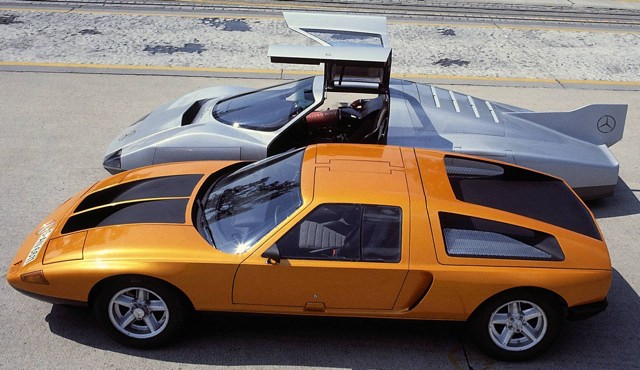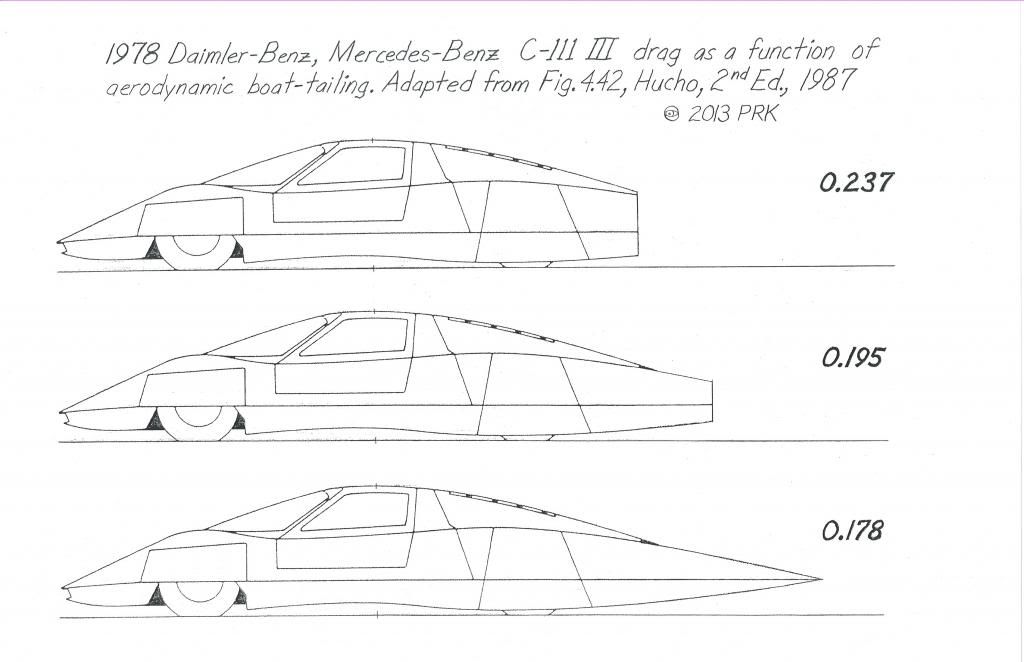 02-25-2010, 11:17 PM
02-25-2010, 11:17 PM
|
#21 (permalink)
|
|
Master EcoModder
Join Date: May 2008
Location: Maynard, MA Eaarth
Posts: 7,908
Thanks: 3,475
Thanked 2,953 Times in 1,846 Posts
|
|
|
|

|
|
The Following User Says Thank You to NeilBlanchard For This Useful Post:
|
|
 Today Today
|
|
|
|
 Other popular topics in this forum...
Other popular topics in this forum...
|
|
|
|
 02-26-2010, 07:08 PM
02-26-2010, 07:08 PM
|
#22 (permalink)
|
|
Master EcoModder
Join Date: Jan 2008
Location: Victoria , Australia.
Posts: 499
Thanks: 20
Thanked 46 Times in 33 Posts
|
There was talk of making a road going version using the 5 cylinder diesel to replace the 4 rotor rotary of the experimental cars and Mercedes did extensive research and published quite a few papers on the idea.
Other demands meant the project was halted but the 5 cylinder moved to the production line and was used in the W123 series cars initially (1976 to 1985) and other variants later.
There were also scale models made in die cast in 1:18 th scale of the road going prototypes and some were available from MB dealers at the time.
Pete.
|
|
|

|
|
The Following User Says Thank You to Peter7307 For This Useful Post:
|
|
 02-26-2010, 07:45 PM
02-26-2010, 07:45 PM
|
#23 (permalink)
|
|
Master EcoModder
Join Date: Jan 2009
Location: Maui, Hawaii
Posts: 813
Thanks: 5
Thanked 34 Times in 26 Posts
|
Is that a pointy nose I see?
Why does it have louvres instead of a smooth rear window though?
|
|
|

|
 02-26-2010, 08:15 PM
02-26-2010, 08:15 PM
|
#24 (permalink)
|
|
Master EcoModder
Join Date: May 2009
Location: New Jersey
Posts: 389
Thanks: 25
Thanked 59 Times in 38 Posts
|
Quote:
Originally Posted by winkosmosis

Is that a pointy nose I see?
Why does it have louvres instead of a smooth rear window though?
|
My guess its to cool the engine that is probably located behind the cockpit? |
|
|

|
 02-26-2010, 10:21 PM
02-26-2010, 10:21 PM
|
#25 (permalink)
|
|
Master EcoModder
Join Date: May 2008
Location: Maynard, MA Eaarth
Posts: 7,908
Thanks: 3,475
Thanked 2,953 Times in 1,846 Posts
|
You can see through the louvers (probably) very well. It sure looks like the cooling is in the front.
At the speeds that cars run at, a pointy nose is not required. Look at the Schlörwagen and the Boxfish...
Last edited by NeilBlanchard; 03-09-2010 at 09:17 AM..
Reason: typos
|
|
|

|
 02-27-2010, 12:57 PM
02-27-2010, 12:57 PM
|
#26 (permalink)
|
|
Master EcoModder
Join Date: Oct 2008
Location: Mid-Atlantic
Posts: 491
Thanks: 170
Thanked 69 Times in 44 Posts
|
Phil, bit hard to tell. Was the radiator intake below the stagnation point on the front. I see that the engine compartment was vented to the windwhield "pocket." Looks like a superb setup to minimize radiator drag and windshield stagnation.
|
|
|

|
 02-27-2010, 01:51 PM
02-27-2010, 01:51 PM
|
#27 (permalink)
|
|
Master EcoModder
Join Date: Jan 2008
Location: Sanger,Texas,U.S.A.
Posts: 16,548
Thanks: 24,522
Thanked 7,442 Times in 4,822 Posts
|
looks like
Quote:
Originally Posted by jimepting

Phil, bit hard to tell. Was the radiator intake below the stagnation point on the front. I see that the engine compartment was vented to the windwhield "pocket." Looks like a superb setup to minimize radiator drag and windshield stagnation.
|
I'm away from home so I don't have my own photos to look at,and I can't remember ( hey at my age I'm authorized now ) but it looks like the area below the lowest slat is open right at the stagnation point,and then they've opened up the area,snagging more air with the additional slats/louvers.
Remember,this was a 'track' car,and operated at W.O.T. for hours/days at the Nardo,Italy track.
Daimler would have been very concerned with engine cooling,operating at the ragged edge for so long.
In day to day operation,the car would never require this amount of cooling air.
At Bonneville,My CRX ran with the temp gauge nearly pegged,so I know this is an issue.
As to the cooling system itself,it is exactly what Walter Korff was pushing in 1963,and it also happens to be what put Wunibald Kamm on the map.The energized flow going over the windshield helped to keep the air from stalling which allowed his roofline to work.
And a safety note: Should a radiator or AC condenser explode ( I've experienced this 3-times ) the hot gases from the cooling system will hit dew-point on your windshield,condense,blind you,and you will in all likelihood crash.The gases from the ruptured AC unit will outright blind you.
It's my opinion that the safety risk of this type of mod overshadows any aero benefit.
Maybe better to move the heat-exchangers rearward as in the Ford concept cars. |
|
|

|
 03-08-2010, 11:51 PM
03-08-2010, 11:51 PM
|
#28 (permalink)
|
|
93 Metro Streamliner
Join Date: Oct 2008
Location: Oregon
Posts: 180
Thanks: 1
Thanked 14 Times in 7 Posts
|
I found another great thread on this car, including press release data directly from Mercedes.
C111-IId and C111-III details from Mercedes
 |
|
|

|
|
The Following 3 Users Say Thank You to hypermiler01 For This Useful Post:
|
|
 03-23-2013, 02:30 PM
03-23-2013, 02:30 PM
|
#29 (permalink)
|
|
Master EcoModder
Join Date: Jan 2008
Location: Sanger,Texas,U.S.A.
Posts: 16,548
Thanks: 24,522
Thanked 7,442 Times in 4,822 Posts
|
pointy
Quote:
Originally Posted by winkosmosis

Is that a pointy nose I see?
Why does it have louvres instead of a smooth rear window though?
|
WOW! Sorry I missed this from so very long ago!
Yes,it is a 'pointy' nose.And after revisiting Fachsenfeld's book of 1951 I have a different take on it.
It is the only reference I've seen in which a 'teardrop' was tested 'backwards,' with the pointed end into the airstream.
It's drag is about 29% higher than when going the other direction,but when lowered into ground proximity,and after wheels are added,the drag is less than 15% higher.
The other thing to consider,is that Mercedes-Benz was approaching transonic flow,whereas some parts of the car would be experiencing compressabilty effects and the nose would play a greater role.
What's curious,is that the next year,in 1979,for the C-111 IV,Mercedes shortened and flattened the nose (more like Porsche's 'Flachbau-Schnoz)and then extended the boat-tail almost all the way to 1,500 mm.
Even festooned with all the extra down-force winglets,the C 111 IV measured no higher drag than the III with no wings,but shorter tail,and with extra power pushed above 250 mph for the 1st time.
'Pointy' is okay aerodynamically,but from an automotive standpoint it may not share the architectural caveats allowed the traditional 'teardrop 'forebody,and the necessary windshield angles might render forward vision an optical impossibility.Hucho touches on this aspect of vehicular design.
__________________
Photobucket album: http://s1271.photobucket.com/albums/jj622/aerohead2/
|
|
|

|
 03-23-2013, 03:05 PM
03-23-2013, 03:05 PM
|
#30 (permalink)
|
|
Master EcoModder
Join Date: Jan 2008
Location: Sanger,Texas,U.S.A.
Posts: 16,548
Thanks: 24,522
Thanked 7,442 Times in 4,822 Posts
|
boat-tail and C-111 III drag pictorial
I have taken a table from Hucho and created three images of the C-111 III with :zero,partial,and full boat tail,and their corresponding drag coefficients.

__________________
Photobucket album: http://s1271.photobucket.com/albums/jj622/aerohead2/
|
|
|

|
|
The Following User Says Thank You to aerohead For This Useful Post:
|
|
|